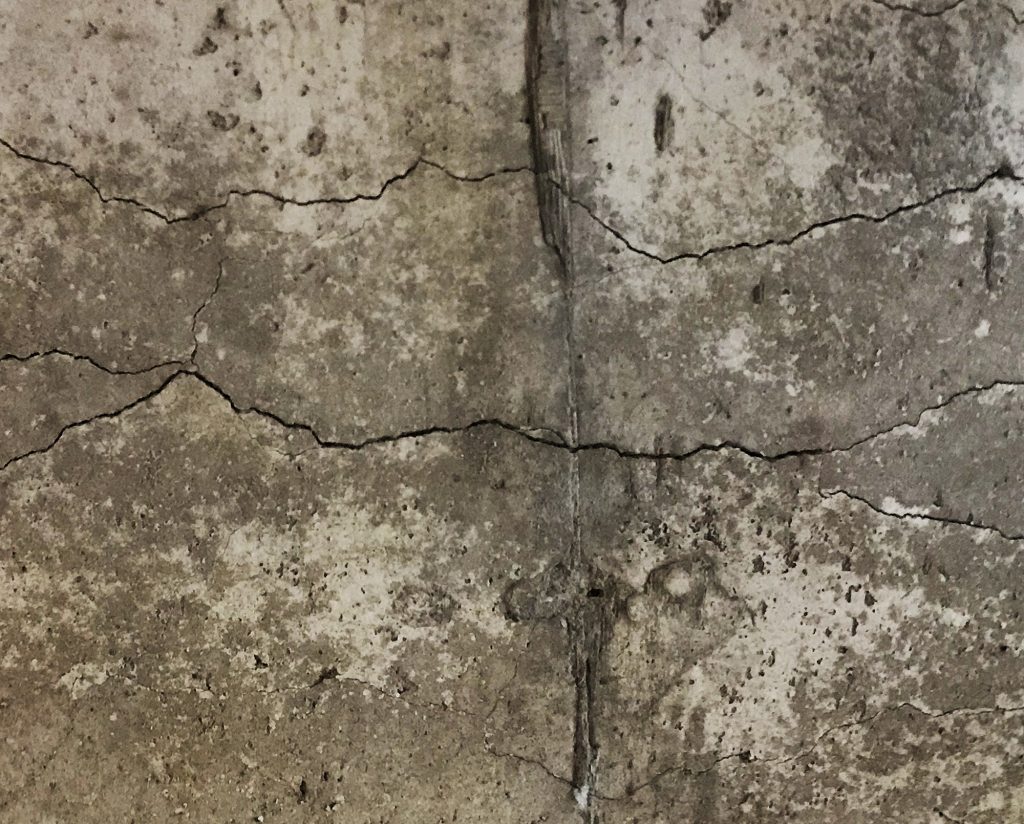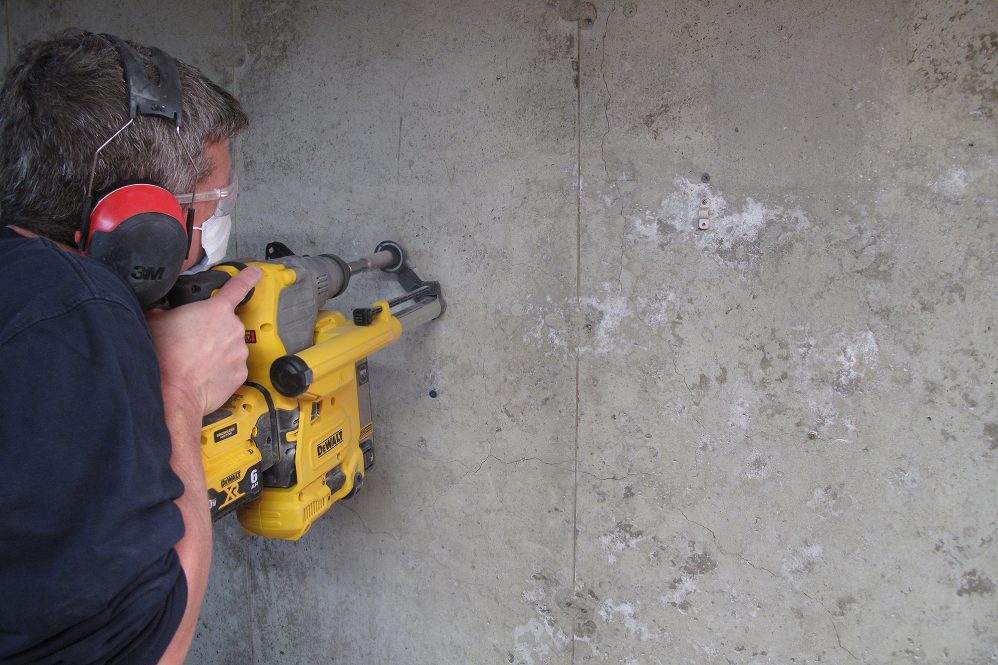In north central and northeastern Connecticut as well as south-central Massachusetts, tens of thousands of homes built between 1983 and 2015 are potentially sitting atop faulty concrete foundations.
But, when some concrete foundations began to crack and crumble, researchers at the University of Connecticut are determined to help homeowners take the best course of action.
With support of almost $7 million in federal grants from the National Institute of Standards and Technology (NIST) in the form of four grants, a team from the College of Engineering is working to better understand the effects of the concrete-degrading mineral pyrrhotite. When exposed to oxygen and water, pyrrhotite expands, triggers additional reactions inside the concrete and can cause a slow deterioration of a home’s foundation.
“With the increasing use of concrete over the last decades sources of good quality aggregates are depleting,” says Kay Wille, associate professor of materials science and engineering and civil and environmental engineering. “But as we expand our quarries to crush more aggregates to make more concrete, we’re going to find other aggregates of potentially lower quality.”

In this case, contractors used a concrete aggregate—unknowingly embedded with pyrrhotite—from a quarry in Willington. The cracking can take 10 to 30 years to appear as the foundation becomes structurally unsound and the costs replace the foundations are typically well excess of a hundred thousand dollars. While the State of Connecticut offers some reimbursement funds, homeowners’ insurance won’t cover the fix—which involves lifting the house, removing the old foundation, replacing the foundation, and securing the home to its new foundation.
“When the rock was removed from this particular quarry, and crushed into the right sized aggregates, they were not tested for pyrrhotite since this problem was not known at that time,” Wille explains. “So over decades unsound aggregates were used for concrete foundations which now show different stages of deterioration and damage.”
Wille, who became involved in studying the crumbling concrete problem in 2015, is a member and Principal Investigator (PI) of UConn’s Crumbling Concrete Research and Testing team. With support of the latest NIST grant, worth $4 million, the team is now working on these five areas of focus:
- Develop an efficient and reliable sampling and testing method to determine the amount of pyrrhotite in the concrete foundations.
- Establish a field-testing program to support homeowners in getting their foundation tested for no additional cost.
- Develop methods for accelerated testing in the lab to better understand how pyrrhotite will affect concrete in a shorter time span.
- Create a risk assessment framework for homeowners to support decision making.
- Determine the effectiveness of potential mitigation strategies to prolong the concrete degradation process.
This work will be accomplished by analyzing more than 450 samples taken from homes with pyrrhotite detected in the foundation. The results help predict the probability of if—and when—a home’s foundation will be failing.
When the research team visits a house for testing, homeowners often ask many questions. “How much pyrrhotite is ‘too much’ in my concrete?” “Is there anything I can do to prevent this?” “Does the [concentration] vary house to house?”
“The goal of this research is to make a defined conclusion for these questions, but that’s not an easy task,” Wille explains. “If we tell them they have a high percentage of pyrrhotite in their concrete foundation, does that mean their foundation crumbles before another house that has a lower concentration? In the last few years we have collected data with consistent quality from the field which already allow us to start making prediction with a certainty, whether this house will be failing in 10 to 20 years.”
While there isn’t a way to prevent pyrrhotite from causing concrete degradation, the next step is to explore options for mitigating the damages.
“In order to understand whether mitigation strategies are going to be effective, we need to fast forward to understand, OK, is this going to prevent the deterioration from happening. This is a very critical piece of the research,” explains PI James Mahoney, a research engineer specializing in transportation construction materials and an associate program director of UConn’s Connecticut Transportation Institute. “The last thing we want to do is tell a homeowner, use this product on your basement walls and 10 years later you find out, whoops, it didn’t work. It may have prolonged its life, but it’s not the solution.”
Accelerated testing will help develop mitigation plans. This research direction is supported by Lesley Frame, assistant professor of materials science and engineering.
“If there’s something that can slow down the rate of reaction and have a positive impact, we need to be able to make sure that with the accelerated testing that it will actually bear out,” Mahoney said.
The Inspection Process

While Wille oversees ongoing research, Mahoney manages a group of experts who conduct field tests on site. The service is free to eligible homeowners in the affected areas of Connecticut and Massachusetts.
“First, we’ll make a visual inspection and note any visible cracking, and then, we’ll drill into foundations, collect the material, and bring that material back to the labs at UConn and test it for pyrrhotite concentrations,” Mahoney explains.
The material undergoes a microstructural analysis at laboratories throughout campus including the Advanced Cementitious Materials and Composites (ACMC) Lab, the Central Electron Microscopy Facility, the Geoenvironmental Engineering Lab, Thermo Fisher Scientific Center for Advanced Microscopy and Materials Analysis (CAMMA) Lab, and others inside the Connecticut Transportation Institute, Institute of Materials Science and the Innovation Partnership Building at the UConn Tech Park.
The team uses multiple instruments such as optical microscopes, scanning electron microscopy (SEM), X-ray diffraction (XRD), X-ray fluorescence (XRF), and elemental analysis systems to determine the elemental composition of the samples. Several graduate students, who are pursing degrees in civil engineering, materials science and engineering, and environmental engineering, assist with the testing and analysis.
Ultimately, the homeowners receive a report of the team’s findings. The report is also added to the team’s database and is used to help predict the risk of future foundations failing.
“We’re very fortunate at UConn to have access to so many instruments and world-class facilities such as the Central Electron Microscopy center, which are crucial for this type of research,” says team PI Marisa Chrysochoou, professor and head of the Department of Civil and Environmental Engineering.
UConn’s Early Involvement
In August 2015, the Attorney General and Commissioner of the Consumer Protection of the State of Connecticut reached out to Wille, who directs the CoE’s ACMC lab and specializes in concrete technology and material design.
Around this time, many homeowners in the eastern area of the state were noticing deterioration of their concrete foundations.
“They asked if our team could assist in investigating why certain concrete has failed prematurely,” he recalls.
Wille agreed to the challenge and formed a team.
Initially, the investigators explored the idea of how environmental conditions, including soil conditions, could impact the deterioration of concrete. But it wasn’t until the researchers collected and examined the microstructures of material samples that they determined the crumbling culprit—the oxidation of pyrrhotite-containing aggregates and expanding minerals.
Eight months later, Wille and postdoctoral researcher Rui Zhong released a report titled “Investigating the Deterioration of Basement Walls Made of Concrete in CT” for the Attorney General’s Office. The report was shared with the Governor’s Office to bring awareness that consumer protection laws at the time did not provide relief to homeowners affected by the deteriorating concrete.
Mahoney joined the research team in 2017 after dealing with the crumbling concrete firsthand. In March 2016, the Ellington resident noticed the cracking pattern typical of pyrrhotite damage in his foundation.
“As a homeowner, it was quite devastating, but of course, as a scientist, I was thinking, let’s see if we can turn lemons into lemonade,” he says. “Realizing that UConn has a lot of capabilities and ability to help with this problem, I started getting involved.”
After completion of the work for the CT Attorney General, UConn provided seed funding to help jump start the research into developing a test method to detect the presence of pyrrhotite in concrete in 2019. This seed funding was vital for securing the subsequent NIST research funding which started in 2020.
For more information or to request a core sample test, visit the Crumbling Concrete Research and Testing website.



